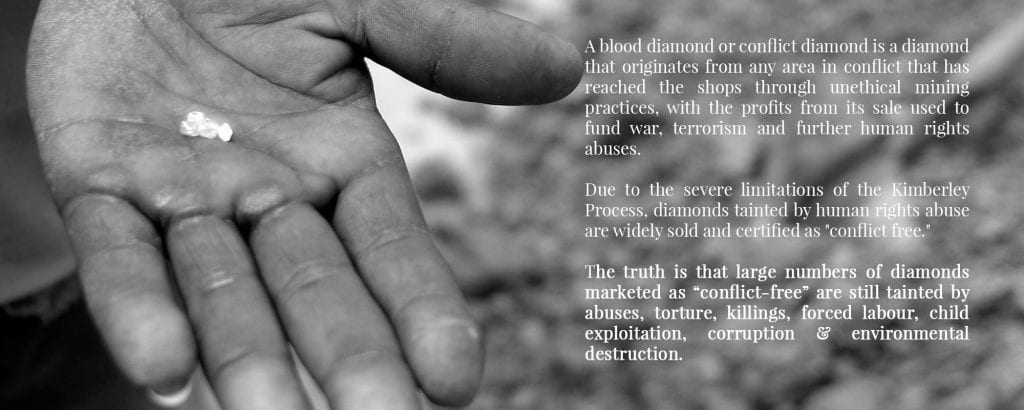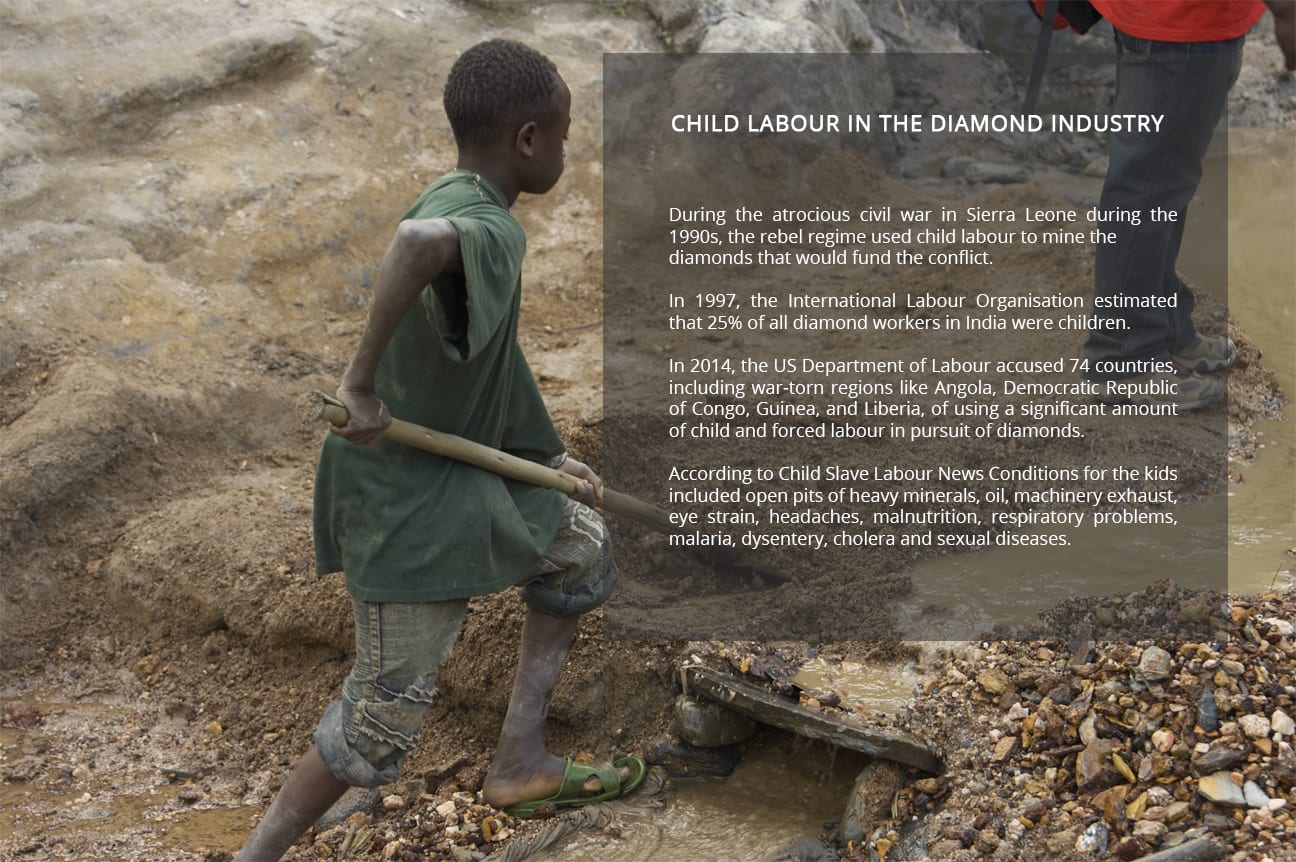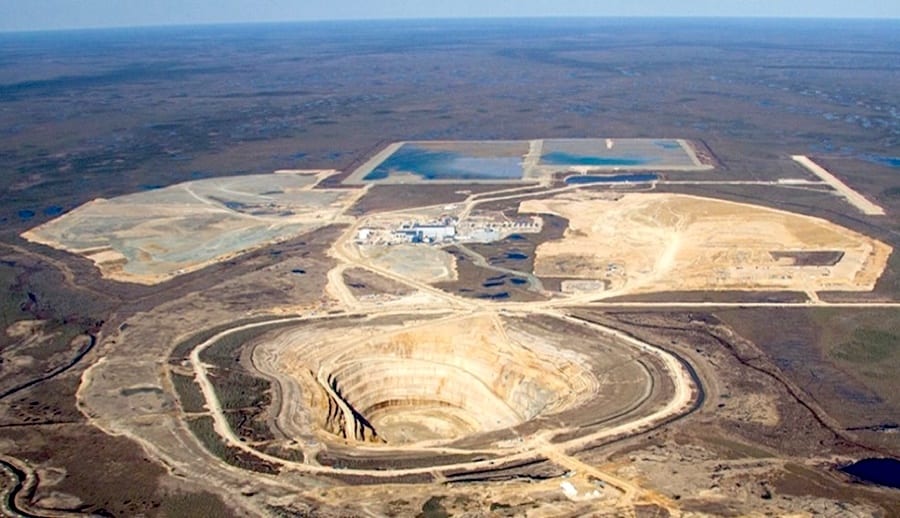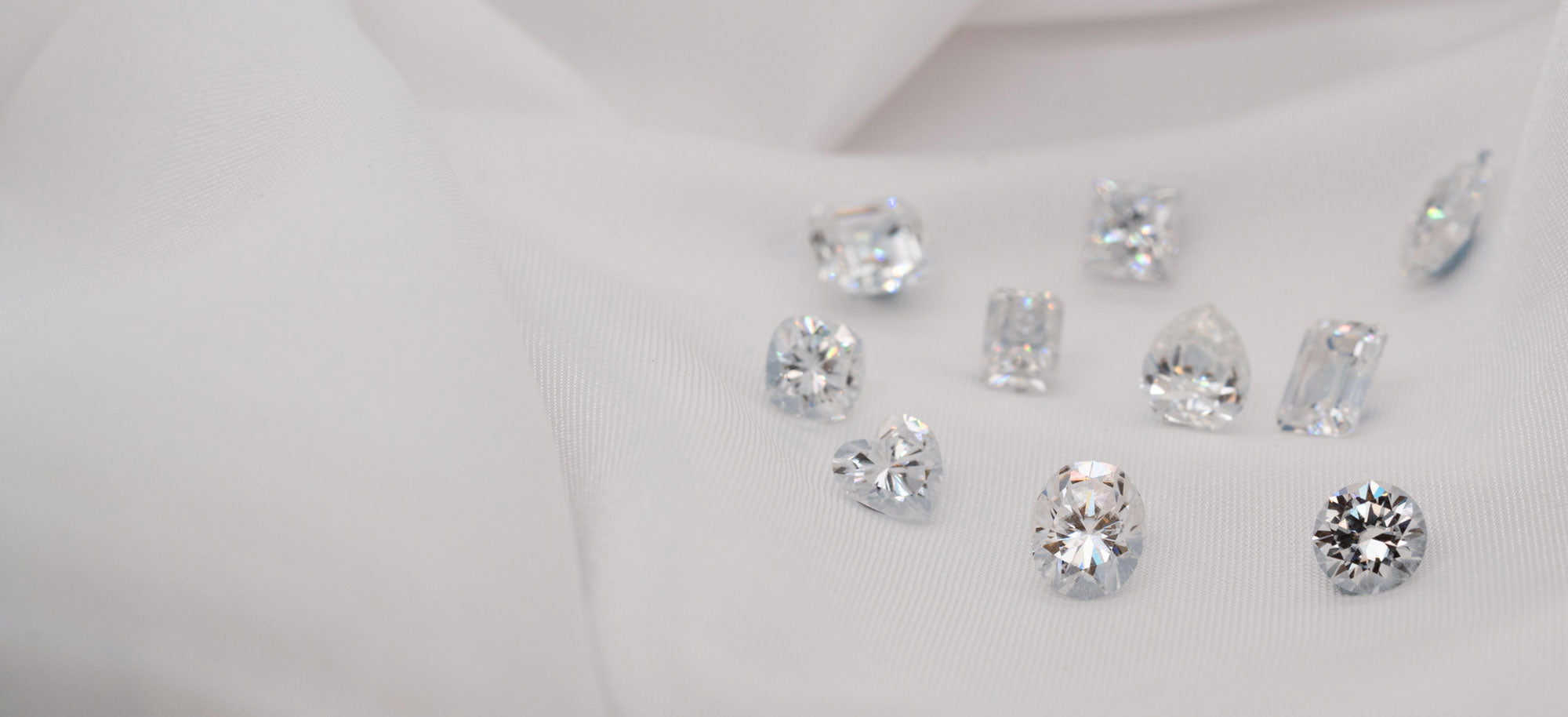BLOOD DIAMONDS MASQUERADE AS CONFLICT DIAMONDS
Would you want to purchase a product with the knowledge that the money you’ve paid could possibly be used to fund terrorism or dictatorial regimes in other countries? Few would, but many are doing so without ever realising it through the unwitting purchase of blood diamonds. This is because even now, many of these stones are masquerading as ethical or conflict free diamonds.
It’s no secret that the diamond mining industry is rife with corruption. Those beautiful diamonds may look pure but source them back to their origins and you’ll find a tortured reality glazed in blood, conflict and abuse. This is not the blurb to an action b-movie, this is the reality behind consumer culture in the jewellery market – they aren’t called blood diamonds for nothing.
Diamond mining practices
The mining of diamonds is achieved in more than one way, the most common being large scale mining and artisanal/small scale & alluvial mining. However, no matter how a diamond is mined, it can be guaranteed that it has not been mined without conflict. It’s not just the humane conflict that taints the purity of these diamonds but also the ecological implications on the Earth that bore us.
Consider this – it requires, on average, the excavation of 250 tons of rock to produce a single carat during a mining operation. How can any process that involves this kind of change to the landscape ever be truly sustainable and environmentally friendly? Any large-scale mining operation is going to have an impact on the local environment and is therefore, not free from conflict.

Is there any such thing as a conflict free mined diamond? And how can you tell?
'Blood diamonds’, or ‘conflict diamonds’, are rough diamonds that originate from situations where the proceeds of diamond mining are used by rebel movements or their allies to finance armed conflicts aimed at undermining legitimate governments, where slave labour, and human rights abuses take place. The 2006 film Blood Diamond, starring Leonardo DiCaprio brought this issue into the public consciousness, but the mined diamond industry had been working hard for a few years prior to that to try to remove these conflict diamonds from the international diamond trade.
The Kimberley Process - The biggest flaw in the diamond industry
In 2003, an international diamond certification scheme known as the Kimberley Process was put into place, between diamond producing countries, diamond handling companies and human rights organisations with the sole intention of stopping such conflict diamonds from entering the consumer market as ‘an international certification scheme for rough diamonds’. The definition used on the Kimberley Process website is:
"Countries where blood diamonds are being mined are banned from selling on the international market, and certificates are issued with approved diamonds, to prove their origins".
Interestingly, even the KP website states that you cannot guarantee where a diamond comes from, and administrative controls must be used to track and verify the origins of diamonds. At time of writing there are warnings live on the KP website concerning fake certificates regarding diamonds from Congo (DRC), Angola, Malaysia, and Ghana.
It is by far the most well-known effort to regulate the diamond trade; however, it is severely flawed. The Kimberley Process focuses exclusively on conflict diamonds and does not provide a guarantee that a diamond has been ethically sourced. In addition, the Kimberley Process is vulnerable to fraud. Due to rampant smuggling and corruption within governmental bodies, diamonds receiving Kimberley Process certification – which may not even be valid - could have come from literally anywhere.
This scheme only attempts to keep conflict diamonds – narrowly defined as diamonds that finance rebel movements – out of the diamond supply. Regrettably, it still grants “ethical diamond” certification to diamonds tainted by violence, child labour, extreme poverty, worker exploitation, and environmental harm.
Regardless of this fact, the Kimberley Process remains to be the only certification system that most diamond retailers rely on in order to trace the origins of their diamonds.
By relying so heavily on such a flawed certification scheme, many diamond retailers are - albeit unknowingly - unable to sufficiently address ethical concerns and can only claim that what they sell are “ethical diamonds” according to the Kimberly Process. The truth is that large numbers of diamonds marketed as "ethical diamonds" are tied to abuses such as torture, rape, killings, beatings, forced labour, child labour, corruption, and huge environmental devastation.
The United Nations have shed light on this issue extensively in the past but unfortunately these blood diamonds still make their way into the UK.

Acknowledged significant loopholes in the KP system
- The KP only prohibits diamonds connected with rebel movements and insurgency, not corrupt legitimate governments.
- The KP can’t touch diamonds from government-owned mines where human rights abuses are taking place, including torture and murder.
- Tax fraud or money laundering aren’t a good reason to ban diamonds, under KP rules. (These three examples are all taking place in Angola and Zimbabwe currently.)
- The best they can do to protect customers against falsified paperwork is to warn people that it exists. There is a surprising amount of diamonds originating from countries which are next door to banned countries, for example from Central African Republic via Cameroon during a ban in 2016.
- The KP definition isn’t broad enough to cover child labour, which includes an estimated 1 million children in small-scale mines.
- The diamonds turn from rough to polished during the chain from mine to jewellery buyer, and the KP only tracks the rough diamonds. Rough diamonds change hands many times, and are sold in bundles before being cut and polished – and the verification is not watertight between the rough diamond and finished cut diamond.
- Global Witness, a human rights organisation which was one of the founding members of the process, pulled out in 2011, saying that the process is not fit for purpose. Their spokesman says, “If consumers think a Kimberley Process certificate means they are free of conflict financing or human rights abuses, they would be wrong.”
Since then, Impact (formerly Partnership Africa Canada) has also announced its withdrawal from the process, with their Executive Director telling reports that, “Consumers are being sold something that is not real”.
Every mined diamond that is certified by the GIA, the Gemological Institute of America, has a serial number, so that individual cut diamonds can be tracked through to final sale. On a report issued with each gem that it examines, the various characteristics of cut, clarity, carat and colour are given, and at this point in time, country of origin is only specified if the diamond comes from Canada, Russia, Botswana, South Africa, Namibia and Australia. Other countries are joining this Diamond Origin service as processes are tightened up to allow it.
CANADIAN DIAMONDS ARE NOT AN ETHICAL CHOICE
Even with relatively well-regulated diamond mining operations, such as the ones taking place in Canada, the environmental impact is being felt despite strict regulations, environmental impact can not be avoided. Therefore any diamonds that are sourced from these regions cannot truthfully carry a truly "ethical diamond" label. The acidic water runoff from mining operations has a serious impact on local aquatic life – a problem that is unlikely to ever be fully remedied, although in Canada, steps have been taken by the government to minimise the problem. However, agreed levels of these chemical discharges are being exceeded. Canadian diamonds are advertised as conflict free and extolled as consumer friendly but this is misleading information supplied to consumers in order to sell these diamonds as an Earth-friendly and sustainable option.. Several reputable organisations have reported on the irreversible damage to the land, the wildlife and the indigenous tribes living in the diamond mining regions.
The environmental effects of large scale mining operations include:
- The draining of lakes, destruction of streams, and changes in the quality of the water, costing fish their natural habitats. It’s possible for whole lakes to be permanently ruined or destroyed altogether in this way. Ammonia discharge from mines is a serious problem here, as it is often significantly greater than was originally agreed upon.
- The loss of land-based habitats for local wildlife, thus dramatically reducing biodiversity.
- Increased production of greenhouse gases. Diamond mines require huge amounts of fuel to run properly. Each individual mine therefore produces a large amount of greenhouse gas each year.
- Social impact on local communities, with many people being forced to relocate due to both health concerns and the loss of their livelihood.
Further reading:
Are Canadian Diamonds Ethical? - Part 1
Are Canadian Diamonds Ethical? - Part 2
Are Canadian Diamonds Ethical? - Part 3

De Beers Victor Mine

Huge holes in the Earth - The Diavik mine in Canada located in the remote Northwest Territories produces diamonds for high-end jewellery in markets worldwide. The British-Australian mining giant Rio Tinto announced plans for a $350 million expansion of its operations there. Photo by DigitalGlobe
What about traceability?
As we are all now living in a world that is more closely focussed on ethics and traceability, it is hardly surprising that jewellers have been staking their claim to be selling "conflict free Canadian diamonds". Canadian diamonds are being marketed with kite marks and laser etching of maple leaf emblems being employed to ensure that Canadian diamonds are distinguishable and therefore a truly ethical choice. There is a statement of certification that is issued by the regulatory body for Canadian diamond mines, under the Canadian Diamond Code of Conduct, which should go alongside any cut diamond that is offered for sale, proving its Canadian origins.
There was controversy in the press in 2017, as an investigative vlogger Jacob Worth, with insider knowledge of the diamond industry, called out ethical diamond retailer Brilliant Earth over the origins of some of its stones. He found stones listed on their website as Canadian that were listed elsewhere without that designation, and spoke with diamond traders who said that they had no Canadian stones. Almost immediately after these conversations, Brilliant Earth issued a cease-and-desist notice, which was followed up by letters from the traders stating that all their stones were in fact of Canadian origin. Worth went public with this information, which all hit rather close to home for Brilliant Earth, with their reputation built on ethics and environmental sustainability, but the subsequent lawsuit attacked the personal credibility of Worth, rather than seeking to deny the claims.
The original videos have been removed from You-Tube, and the lawsuit has been ‘discontinued with prejudice and without any costs or disbursements’ according to a notice filed on 27 October 2017 in New York Supreme Court. However, an article by TNW explains the content, and goes further in its investigation of Brilliant Earth. The TNW journalist found extensive evidence of diamonds being listed as Canadian on Brilliant Earth’s website, but without that designation anywhere else.
Without wishing to dive further into the investigative journalism that appears to have got Mr Worth into trouble, all we would like to point out is that this shows how easy it is to make claims about diamonds and ethics without the ‘man on the street’ being able to verify whether they are in fact true.
In our opinion, the only truly ethical diamonds are those which are not mined at all, i.e. lab-grown, or man made which stars in many of the Ethica Diamond Collections. You can find out more about lab grown diamonds and the Ethica Diamond elsewhere in our blog, and on our website.
TRULY ETHICAL DIAMONDS
Ethica Diamonds has chosen to go against the grain by emulating the purity and beauty of traditionally mined diamonds with our unique Mad-made Diamonds. These ethical, man made diamonds originate from ethical origins and offer the same level of aesthetic wonder and quality that you would find elsewhere but without the circumstantial guilt that comes with a questionable past. Just as we often buy fairtrade products to ensure that farmers who produce our food are getting a fair deal, we should do what we can to ensure the jewellery that gives us so much pleasure is not ruining the lives of others.
By choosing our Ethica Diamonds, you are supporting our mission is to cultivate a transparent, and sustainable jewellery industry. We hold true to our values of awareness and transparency by guaranteeing that the Ethica Diamond is, and always will be, environmentally friendly, responsible and therefore, completely free from both humanitarian or ecological conflict.
Our Ethica Diamond offers you a perfectly formed diamond without any greenhouse emissions, water or air pollution. We have absolutely no association with any immoral national or international trade or mining companies and all work is carried out ethically, affordably and with the utmost care for quality.
So if you're looking for the best diamond alternative available consistent with your values, Ethica Diamonds guarantee that, by choosing our diamonds, you will be purchasing a truly conflict free diamond that is in line with the ethical credentials. There is no need to compromise on quality, authenticity or sustainability and each stone comes with full independent GRI certification.

Ethica Diamonds produce beautiful diamond jewellery for the 21st century consumer, with no compromise on longevity, durability or ethics.
Sources
https://www.ft.com/content/76019f26-01f5-11e8-9e12-af73e8db3c71 https://impacttransform.org/en/non-profit-announces-departure-from-conflict-diamonds-certification-scheme/ https://www.gia.edu/ https://thenextweb.com/insider/2017/06/17/shady-online-diamond-dealer-proves-conflict-free-is-no-guarantee/ https://thenextweb.com/insider/2017/07/28/youtuber-who-exposed-ethical-diamond-scam-is-now-being-sued/ https://www.jckonline.com/editorial-article/brilliant-earth-settles-suit-internet-critic/
Read Next

The Senara Collection - Cornwall Inspired Jewellery That Makes A Difference

Kelvin & Clare's Engagement Story | A Proposal On The Jurassic Coast
Kelvin proposed to Clare on the Jurassic Coast with an ethical Piper engagement ring sample on the way down to beautiful St Mawes, Cornwall. He then surprised her with an appointment in our Truro showroom, where together they picked out the beautiful lab-grown diamond Felicia ring.



